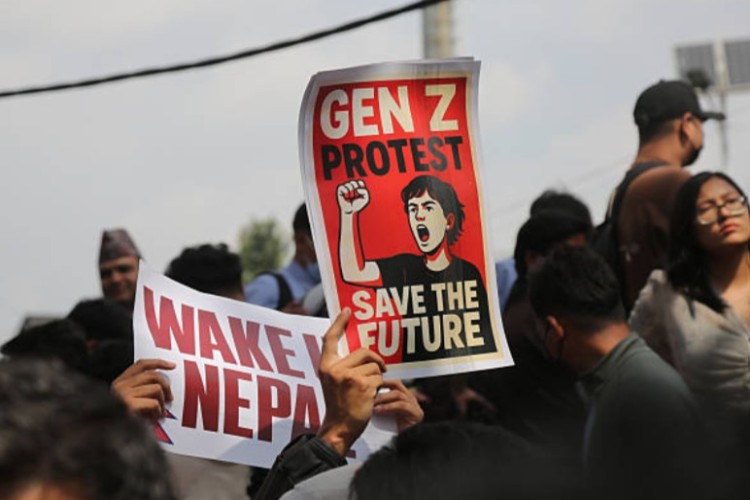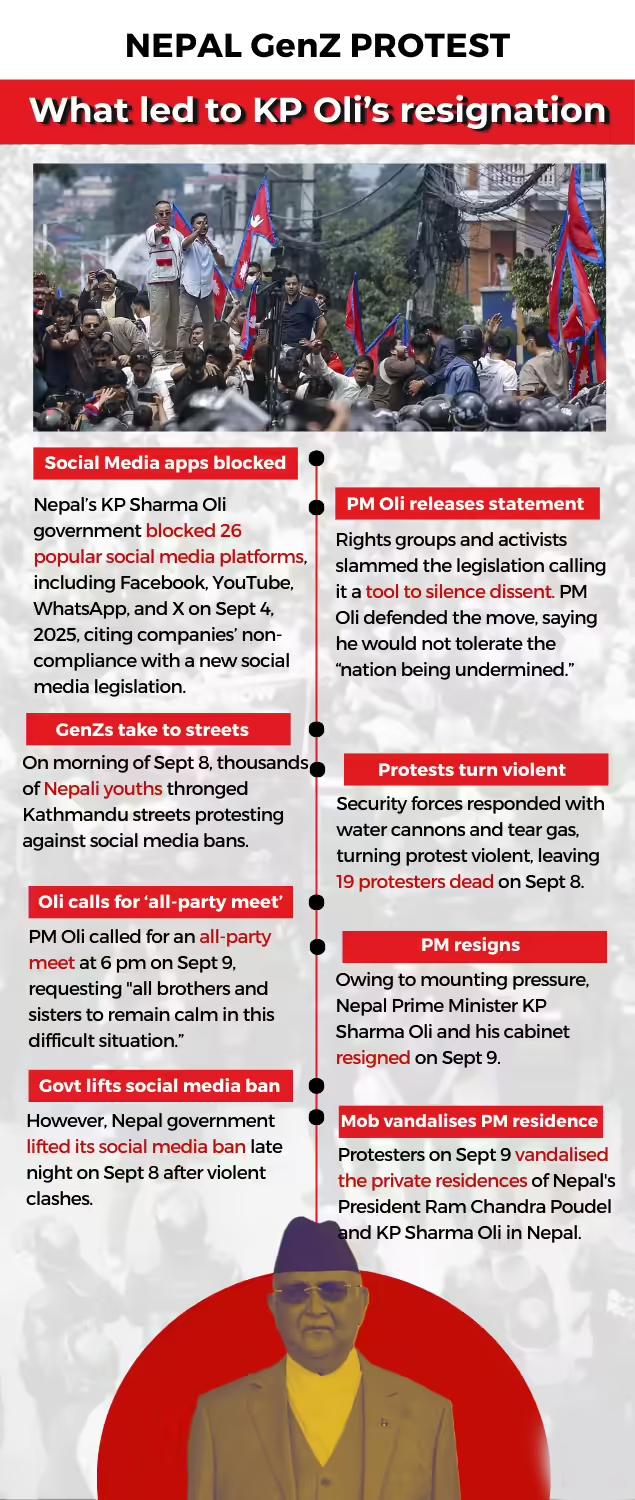Context
Nepal is witnessing one of its most intense waves of youth-led protests in recent days, popularly termed the Gen Z Protests. The immediate trigger was a government ban on 26 major social media platforms, including Facebook, Instagram, WhatsApp, X, and YouTube.
- The move sparked outrage, particularly among young Nepalis who rely on these platforms for expression, connection, and livelihood. Within days, thousands of students, many in their school uniforms, were on the streets of Kathmandu demanding accountability and political reform. The demonstrations have led to the resignation of Prime Minister KP Sharma Oli and left more than 22 people dead.
- The crisis carries regional implications, especially for India, which shares an open 1,751-kilometre border with Nepal. As India steps up security measures, questions arise over Nepal’s political stability, governance, and the future direction of this movement led largely by Generation Z.
What Triggered the Protests?
The immediate catalyst was the Nepali government’s decision to ban 26 social media platforms, including WhatsApp, Instagram, and Facebook. Authorities claimed the platforms had failed to register with the Ministry of Communication and Information Technology by the stipulated deadline.
However, social media is integral to daily life in Nepal, which has one of the highest user rates per capita in South Asia. The ban instantly provoked anger. Critics accused the government of using the pretext of regulation to stifle dissent and weaken anti-corruption campaigns that had gained momentum online.
The decision also disrupted education, as many students depended on these platforms for online classes and study resources. This reinforced the perception that the ban was not just about regulation but about silencing youth voices. Facing backlash, the government repealed the ban within days, but by then the protests had spiralled far beyond the initial grievance.
Reason behind Ban: The government justified the ban on the grounds of non-compliance with its regulatory orders. For over a year, Nepal has been trying to push global social media giants to:
· Register with the government,
· Appoint a grievance officer, and
· Remove content flagged by authorities.
When companies refused, the government, backed by a Supreme Court order, imposed a blanket ban.
Platforms that complied, such as TikTok, Viber, WeTalk, Nimbuzz, and Poppo Live, were spared. TikTok, previously banned in 2023, managed to resume operations after agreeing to government terms.
Social Media Regulation:
The Nepal episode is part of a broader international debate on regulating Big Tech. · Arguments for regulation: Governments contend that social media platforms enable the spread of misinformation, hate speech, cybercrime, and foreign influence operations. Regulation is seen as essential for national security and social stability. · Arguments against regulation: Civil society actors warn that governments often invoke these concerns to justify censorship, surveillance, and restrictions on fundamental rights such as freedom of speech and association. South Asia has witnessed similar measures: · Pakistan has periodically banned X and TikTok, particularly during episodes of political unrest. · Sri Lanka restricted Facebook during its 2018 constitutional crisis. · Myanmar imposed a nationwide internet blackout following the 2021 coup. · India has not pursued blanket bans (with the exception of Chinese apps in 2020) but regulates platforms under the Information Technology (Intermediary Guidelines and Digital Media Ethics Code) Rules, 2021. Nepal’s choice of a comprehensive ban placed it closer to the restrictive approaches of authoritarian regimes, rather than the regulated accommodation seen in India. |
Who Is Protesting?
This movement is strikingly different from Nepal’s earlier political uprisings. It is youth-led, digitally mobilised, and framed around generational identity.
· Protesters identify as Gen Z, turning the term into a rallying symbol.
· Youth collectives and informal student groups have emerged as organisers, spreading calls to action online.
· Students from universities in Kathmandu, Pokhara, and Itahari have joined in uniforms, some carrying books to symbolise their demand for an accountable future.
· Even schoolchildren have been seen participating, underscoring how deeply the discontent has penetrated Nepali society.
The movement’s demands are both immediate and systemic:
1. Restoration of freedom of speech and digital rights (already achieved with the lifting of the social media ban).
2. End to corruption and nepotism, which protesters identify as the root of Nepal’s governance failures.
Implications for India–Nepal Relations:
India has historically maintained close ties with Nepal through geography, culture, and open borders. Political instability in Kathmandu complicates these relations in several ways:
1. Policy Uncertainty: Frequent leadership changes delay projects on trade, connectivity, and energy cooperation.
2. Security Concerns: Unrest in Nepal can spill over across the open border, with potential implications for migration and security.
3. Geopolitical Competition: China has consistently sought to expand its influence in Nepal through infrastructure investments. Instability risks pushing Nepal further into Beijing’s orbit.
The timing of the crisis is noteworthy. Oli had recently returned from the Shanghai Cooperation Organisation (SCO) Summit in China, and he was scheduled to visit India in September.
India’s Development Partnership with Nepal
India is Nepal’s single largest development partner since the 1950s. Assistance is targeted at infrastructure, health, education, and grassroots capacity-building. · Earthquake Reconstruction (2015): India pledged $1 billion, including $250 million as grant. · Community Development: Over 300 school buildings, hospitals, and roads built under the High-Impact Community Development Projects (HICDPs). As of 2024, India has donated 1,009 ambulances and 300 school buses. · Connectivity Projects: o Cross-border road and rail links, including the first broad-gauge passenger train to Biratnagar and freight rail to Kathmandu. o Cross-border fuel pipelines: Motihari–Amlekhgunj (Phase I operational in 2019, Phase II ongoing) and Siliguri–Jhapa pipeline. · Energy Cooperation: Joint Vision on Power (2022) envisions 10,000 MW of Indian clean energy imports from Nepal by 2034. Projects include: o Arun-III Hydropower Plant (900 MW) o West Seti (750 MW) o Phukot Karnali Project · Digital and Institutional Engagement: o Launch of UPI mobile payments in Nepal (2024). o Over 38,000 Nepali students have received Indian scholarships since 2001. o Legal cooperation MoU between the Supreme Courts (2025). o Discussions for IIT/IIM satellite campuses in Nepal. Security and Defence Cooperation: The open border, while a facilitator of ties, also requires joint security management against smuggling, crime, and insurgency. India trains and equips Nepal’s armed forces, while over 32,000 Nepali Gurkhas serve in the Indian Army’s Gorkha regiments.
India and Nepal are founding members of SAARC and BIMSTEC, and cooperate on subregional initiatives like the BIMSTEC Transport Connectivity Master Plan. Nepal supports India’s bid for a permanent seat in the UN Security Council. Challenges in India-Nepal Relationship
|
Conclusion
Nepal is at a crossroads. What began as a protest against a social media ban has transformed into a generational uprising against corruption, inequality, and unfulfilled promises of democracy. With KP Sharma Oli’s resignation, the country faces uncertainty, as the movement remains leaderless but deeply mobilised.
For India, the crisis presents both challenges and opportunities. Instability in Nepal could strain border security, disrupt trade, and complicate regional geopolitics. At the same time, India’s restrained approach allows it to maintain neutrality and focus on long-term cooperation.
Ultimately, the protests reflect a simple truth: Nepal’s youth are demanding accountability, fairness, and dignity. Unless the political establishment responds meaningfully, the Himalayan nation risks prolonged instability at a time when its people are calling for transformation.
UPSC/CSE Main Question:
“Internal political developments in Nepal have historically had direct repercussions for India’s security and diplomacy.” Discuss.








